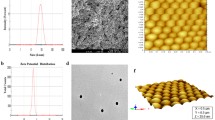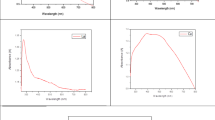Abstract
Safranal, the main bioactive compound in saffron responsible for its desirable aroma, has been widely studied for its various biological potentials in both in vitro and in vivo conditions. In the present research, safranal was encapsulated in poly(lactic-co-glycolic acid) nanoparticles (SAF-PLGA-NPs) as an efficient carrier system and characterized using DLS, ZETA potential, SEM, TEM and FTIR methods. The study aimed to investigate the antioxidant potential and anticancer properties of SAF-PLGA-NPs against two distinct cell lines including normal human foreskin fibroblast (HFF) cells and pancreatic cancer (PANC) cells. The apoptotic gene profiling (Bax, Bcl2, and Caspase 8) was also analyzed to determine the mechanism of action of SAF-PLGA-NPs. The obtained results manifested that SAF-PLGA-NPs were synthesized into round particles measuring 229.19 nm. They were also found to be single-dispersed and stable, with a ζ-potential of − 20.87 mV. The nanoparticles showed strong cytotoxicity activity against PANC cells, with an IC50 value of 35.38 μg/mL compared to normal cells. Moreover, the SAF-PLGA-NPs significantly upregulated the expression of Bax and caspase 8 genes while down-regulating the expression of the Bcl2 gene in the PANC cell line, which is a promising mechanism for treating pancreatic cancer. Our funding suggests that SAF-PLGA-NPs could be a promising drug delivery system and provide a strong foundation for further research on SAF-PLGA-NPs as a potential treatment option for cancer.






Similar content being viewed by others
References
Estanqueiro M et al (2015) Nanotechnological carriers for cancer chemotherapy: the state of the art. Colloids Surf B 126:631–648
Aggarwal K, Madan S, Sarwat M (2022) Traditional nutritional and health practices to tackle the lifestyle diseases. Herbal Medicines. Elsevier, pp 253–269
Larsson SC et al (2020) Smoking, alcohol consumption, and cancer: a mendelian randomization study in UK biobank and international genetic consortia participants. PLoS Med 17(7):e1003178
Beynon RA et al (2018) Tobacco smoking and alcohol drinking at diagnosis of head and neck cancer and all-cause mortality: results from head and neck 5000, a prospective observational cohort of people with head and neck cancer. Int J Cancer 143(5):1114–1127
McGuigan A et al (2018) Pancreatic cancer: a review of clinical diagnosis, epidemiology, treatment and outcomes. World J Gastroenterol 24(43):4846
Rawla P, Sunkara T, Gaduputi V (2019) Epidemiology of pancreatic cancer: global trends, etiology and risk factors. World J Oncology 10(1):10
Tsai H-J, Chang JS (2019) Environmental risk factors of pancreatic cancer. J Clin Med 8(9):1427
Dutta S et al (2019) Natural products: an upcoming therapeutic approach to cancer. Food Chem Toxicol 128:240–255
Pezzani R et al (2019) Synergistic effects of plant derivatives and conventional chemotherapeutic agents: an update on the cancer perspective. Medicina 55(4):110
Abu Elella MH et al (2021) Synthesis of xanthan gum/trimethyl chitosan interpolyelectrolyte complex as a pH-sensitive protein carrier. Polym Bull 79(4):1–22
Mutha RE, Tatiya AU, Surana SJ (2021) Flavonoids as natural phenolic compounds and their role in therapeutics: an overview. Future J Pharm Sci 7(1):1–13
Cosme P et al (2020) Plant phenolics: bioavailability as a key determinant of their potential health-promoting applications. Antioxidants 9(12):1263
Cerdá-Bernad D et al (2022) Saffron bioactives crocin, crocetin and safranal: Effect on oxidative stress and mechanisms of action. Crit Rev Food Sci Nutr 62(12):3232–3249
Catinella G et al (2022) From saffron residues to natural safranal: valorization of waste through a β-glucosidase. Food Bioprod Process 131:144–148
Nanda S, Madan KJH (2021) The role of safranal and saffron stigma extracts in oxidative stress, diseases and photoaging: a systematic review. Heliyon 7(2):e06117
Rezaei A, Fathi M, Jafari SMJ (2019) Nanoencapsulation of hydrophobic and low-soluble food bioactive compounds within different nanocarriers. Food Hydrocoll 88:146–162
Kyriakoudi A et al (2021) Innovative delivery systems loaded with plant bioactive ingredients: formulation approaches and applications. Plants 10(6):1238
Ngwuluka NC et al (2021) Natural polymers in micro-and nanoencapsulation for therapeutic and diagnostic applications: part II-polysaccharides and proteins. Nano Microencapsul Tech Appl 8:9
Arasoğlu T, Derman S (2018) Assessment of the antigenotoxic activity of poly (d, l-lactic-co-glycolic acid) nanoparticles loaded with caffeic acid phenethyl ester using the Ames Salmonella/microsome assay. J Agric Food Chem 66(24):6196–6204
Mohamed F, Ahmed A, Abdel-Gawad OF (2022) Preparation and evaluation of the antimicrobial activity of sodium alginate-grafted diphenylamine embedded with silver nanoparticles. Polym Bull 80:1–14
Abdel-Aziz MM, Elella MHA, Mohamed RR (2020) Green synthesis of quaternized chitosan/silver nanocomposites for targeting mycobacterium tuberculosis and lung carcinoma cells (A-549). Int J Biol Macromol 142:244–253
Dzoyem JP et al (2021) Thymol and piperine-loaded poly (D, L-lactic-co-glycolic acid) nanoparticles modulate inflammatory mediators and apoptosis in murine macrophages. Planta Med Int Open 8(03):e122–e130
Perinelli DR et al (2019) PEGylated polylactide (PLA) and poly (lactic-co-glycolic acid)(PLGA) copolymers for the design of drug delivery systems. J Pharm Investig 49(4):443–458
Elella MHA et al (2021) Xanthan gum-derived materials for applications in environment and eco-friendly materials: a review. J Environ Chem Eng 9(1):104702
Rahmati A et al (2022) Fabrication and assessment of folic acid conjugated-chitosan modified PLGA nanoparticle for delivery of alpha terpineol in colon cancer. J Biomater Sci Polym Ed 33:1–19
Karimi E et al (2018) Phytochemical evaluation, antioxidant properties and antibacterial activity of Iranian medicinal herb Galanthus transcaucasicus Fomin. J Food Meas Charact 12(1):433–440
Tabatabaeain SF, Karimi E, Hashemi M (2022) Satureja khuzistanica essential oil-loaded solid lipid nanoparticles modified with chitosan-folate: evaluation of encapsulation efficiency, cytotoxic and pro-apoptotic properties. Front Chem 10:904973
Elella MHA et al (2020) Antimicrobial pH-sensitive protein carrier based on modified xanthan gum. J Drug Deliv Sci Technol 57:101673
Madannejad R et al (2019) Toxicity of carbon-based nanomaterials: reviewing recent reports in medical and biological systems. Chem Biol Interact 307:206–222
Pool H et al (2012) Antioxidant effects of quercetin and catechin encapsulated into PLGA nanoparticles. J Nanomater 2012(86):86
Pereira MC et al (2018) Effect of nanoencapsulation using PLGA on antioxidant and antimicrobial activities of guabiroba fruit phenolic extract. Food Chem 240:396–404
Jadid MFS et al (2021) Enhanced anticancer potency of hydroxytyrosol and curcumin by PLGA-PAA nano-encapsulation on PANC-1 pancreatic cancer cell line. Environ Toxicol 36(6):1043–1051
Rahimi S et al (2022) Cellular and subcellular interactions of graphene-based materials with cancerous and non-cancerous cells. Adv Drug Deliv Rev 189:114467
Dallavalle S et al (2020) Improvement of conventional anti-cancer drugs as new tools against multidrug resistant tumors. Drug Resist Updates 50:100682
Arya G et al (2018) Evaluation of curcumin loaded chitosan/PEG blended PLGA nanoparticles for effective treatment of pancreatic cancer. Biomed Pharmacother 102:555–566
Aldawsari HM et al (2020) Preparation and characterization of chitosan coated plga nanoparticles of resveratrol: Improved stability, antioxidant and apoptotic activities in H1299 lung cancer cells. Coatings 10(5):439
Acknowledgements
The authors are grateful to the Islamic Azad University of Mashhad for the laboratory facilities.
Funding
There has been no financial support for this work.
Author information
Authors and Affiliations
Contributions
FA was contributed to study design, experimental work, and writing original draft; EK and AN were contributed to analysis, methodology, project administration, supervision, review, and editing of the original draft; All authors read and approved the final manuscript.
Corresponding author
Ethics declarations
Conflict of interest
All the authors declare that they have no conflict of interest.
Data availability
The datasets generated during and analyzed during the current study are available from the corresponding author upon reasonable request.
Ethical approval
This article does not contain any studies with human participants or animals performed by any of the authors.
Additional information
Publisher's Note
Springer Nature remains neutral with regard to jurisdictional claims in published maps and institutional affiliations.
Rights and permissions
Springer Nature or its licensor (e.g. a society or other partner) holds exclusive rights to this article under a publishing agreement with the author(s) or other rightsholder(s); author self-archiving of the accepted manuscript version of this article is solely governed by the terms of such publishing agreement and applicable law.
About this article
Cite this article
Aminaltojjari, F., Neamati, A. & Karimi, E. Synthesis of anticancer drug polymeric carrier based on safranal encapsulated PLGA nanoparticles. Polym. Bull. (2024). https://doi.org/10.1007/s00289-024-05298-7
Received:
Revised:
Accepted:
Published:
DOI: https://doi.org/10.1007/s00289-024-05298-7




